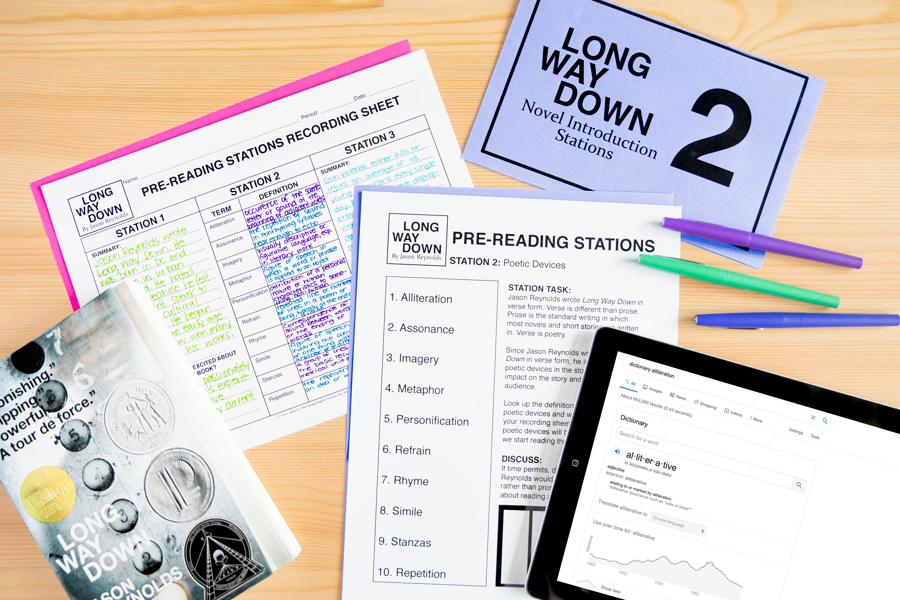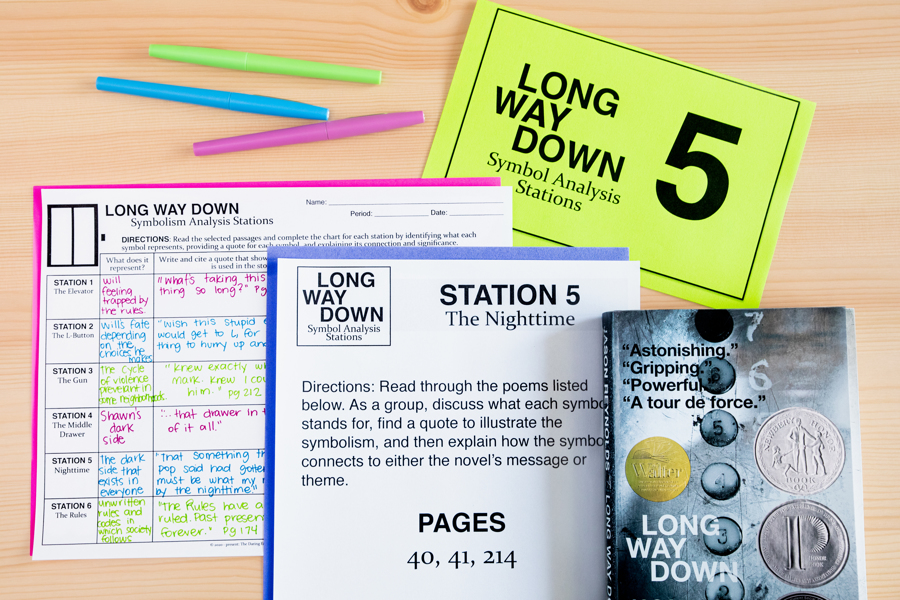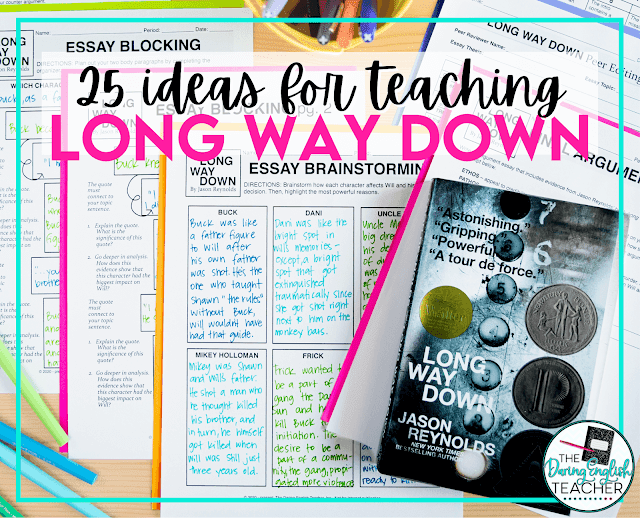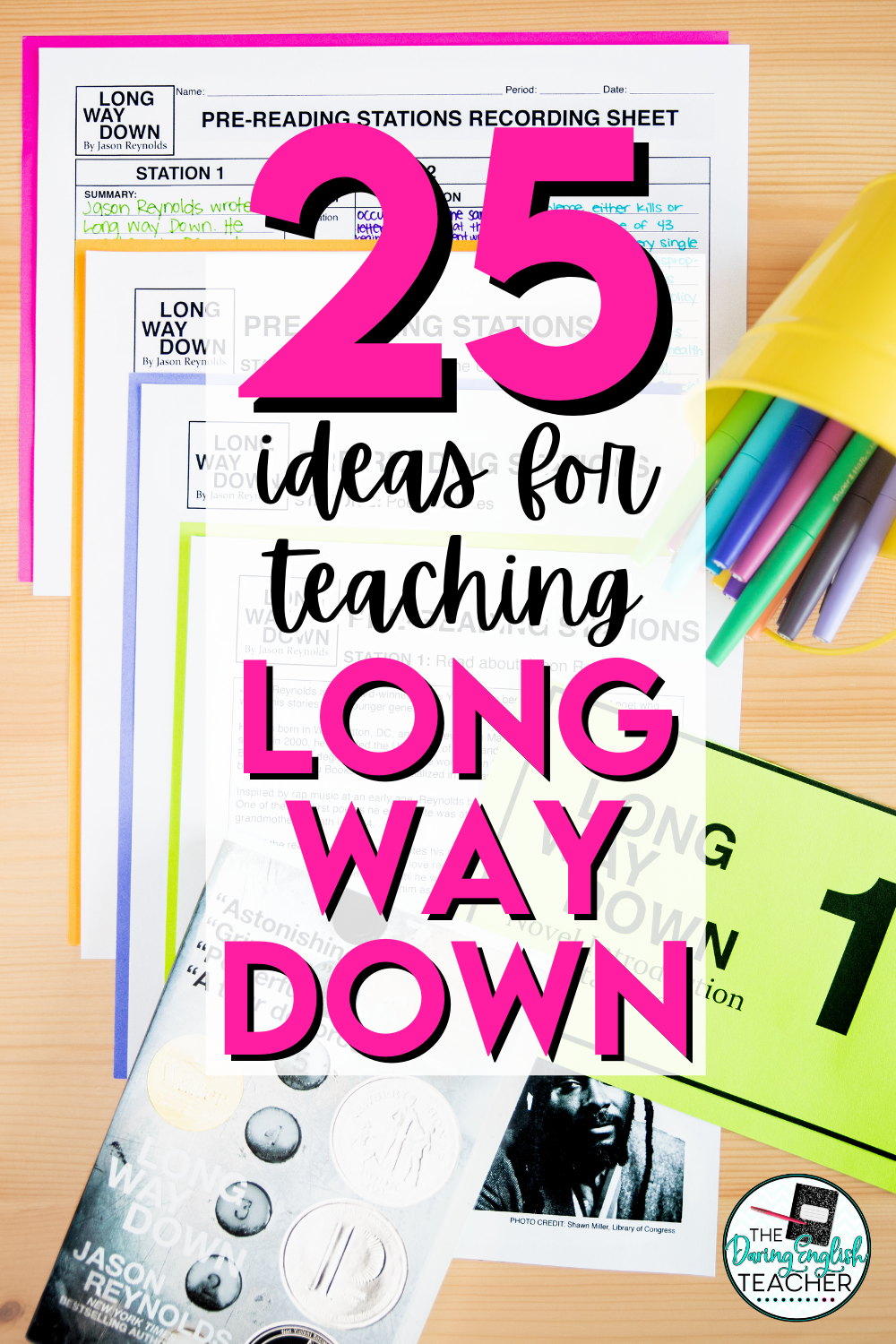So, you want to teach Long Way Down? Long Way Down is a verse novel about a fifteen-year-old boy named Will Holloman. It is a great book that really engages students!
Teaching Long Way Down can be an engaging and thought-provoking unit for your students, and there is so much you can do with this novel study. I use the materials in this Long Way Down Novel Study with my students as we read the text in my classroom. If you are looking at how to teach Long Way Down or activities to incorporate in your classroom when teaching Long Way Down, here is the ultimate list for you.
Here are 25 ideas for teaching Long Way Down.
Teaching Long Way Down: Watch Author Interviews
A great way to introduce students to a novel and author is to have them watch author interviews and videos before reading the book. One of my favorite videos to show my class before reading Long Way Down is the Daily Show interview with Trevor Noah. This is a great introductory interview because students get to know Jason Reynolds, who he is, what he writes, and why he writes.
Teaching Long Way Down: Novel Introduction Stations
Before I start the novel study with my students, I like to have them complete these Long Way Down Novel Introduction Stations as a way to engage with critical information in the novel. This station activity includes three stations: author information, poetic terms, a nonfiction passage about gun violence in the US.
 |
| Long Way Down Novel Introduction Stations |
Teaching Long Way Down: Listen to NPR author interview
Speaking and listening is one common core strand in ELA classes. A great way to introduce the novel is to listen to Jason Reynold’s NPR interview. An ideal way to complete this is to have students listen to the interview twice. Each time, students should actively listen and take notes. Students should be listening for keys, and details that they missed during the initial listen during the second listen.
Teaching Long Way Down: Revenge vs. Justice
Revenge is a strong motif in Long Way Down, and a great way to have students explore this concept is to have them read about and discuss the concept of revenge vs. justice. This article about revenge vs. justice is a great starting point for students. I had them read the article in partners in class and then discuss the key differences between revenge and justice.
Teaching Long Way Down: My name is poem
The second poem of the novel is “MY NAME IS.” It is a poem where Will introduces himself to the audience. Before diving all the way into the novel, read this poem with your students first. After reading this poem, have them work on their own name poem that follows the same structure as “MY NAME IS.”
Teaching Long Way Down: Sticky Note Literary Analysis
A great way to engage with the novel as you read it is to complete this Long Way Down Sticky Note Literary Analysis. This versatile teaching resource includes analysis organizers for literary concepts including conflict, symbolism, figurative language, characterization, tone, setting, and more. As students work with these organizers, they will look for and analyze the chosen literary elements and illustrate and explain the literary concept.
 |
| Long Way Down Sticky Note Literary Analysis |
Teaching Long Way Down: Long Way Down Character study
A great way to complete a Long Way Down character study is to assign different characters to different students and have them trace their connections with Will. As students trace the character development, they should keep track of things like how the character knew Will, what impact the character had on Will, how their past connection with Will might affect his decision, and what message Jason Reynolds is trying to convey through that character. At the end of the novel, have students form groups to discuss character development.
Teaching Long Way Down: Listen to the audio
If you are teaching Long Way Down without incorporating the audio, you and your students are missing out. Long Way Down is a verse novel, and the story is meant to be read, even performed, aloud. When I teach the novel, we read along as we listen to Jason Reynolds narrate the book aloud. Also, by listening to the book, students can see how Reynolds emphasizes certain words, and how that corresponds with the structure of some of the poems. The two work together to create a dynamic pairing. I use the Audible version of the audiobook.
Teaching Long Way Down: Use the Graphic Novel
Sharing the Long Way Down graphic novel with your class is a great way to further engage students in the story. While the audio narrated by Reynolds is captivating, some students are visual learners and will be able to see the story better with the aid of the images from the graphic novel. Another way to engage students in the graphic novel is to compare parts from the verse novel and the graphic novel since the words in each book are not precisely the same.
Teaching Long Way Down: Create and write anagrams
Throughout the novel, Will comes up with anagrams that represent his feelings. Having students create their own anagrams is a great way to have students work on their critical and creative thinking skills. Having students work with anagrams as a bell ringer is also a great way to introduce anagrams. To help scaffold this activity, provide students with one word of the anagram to start. Here are three anagrams to consider including in your classroom: night = thing, brag = grab, and angered = enraged.
Teaching Long Way Down: Mind map
This is one of my favorite activities for the novel. As my students read the story, I have them create a mind map that maps out their understanding of the story as it happens after our first day of reading, and then students add to the mind map each day after we read a certain level. You can read more about this activity in this blog post.
Teaching Long Way Down: Write your own rules
Just as Will Holloman and his friends and family have their own rules they must follow, our students and their families also have their own set of unwritten rules. There are two ways to go ahead and complete this activity. You can have students work in small groups deciding on three unspoken class rules that students must follow to be successful in your class, or you can have students work separately to come up with three family rules that they follow at their one home.
Teaching Long Way Down: Maslow’s Hierarchy of Needs
This novel is the perfect entry point to introduce your students to Maslow’s Hierarchy of Needs and get them thinking critically about Will. After reading level 4 with students, I like to introduce them to the Hierarchy of Needs. After doing so, I engage my students in a class discussion where they analyze where they think Will is and why. Then, I have them journal about where they believe they are on the Hierarchy of Needs.
Teaching Long Way Down: Track and Analyze Timestamps
Once Jason Reynolds introduces the timestamps, students can know just how much time is passing. By tracing and analyzing the timestamps, students will begin to see how there is no way possible for the story to play out in real-time. There just isn’t enough time. One way to track the timestamps is to have students keep a log of all of the timestamps. Instruct students to write down every timestamp that Reynolds includes and two quick details of what happens during that timestamp.
Teaching Long Way Down: Exploring poetry
Before reading the verse novel, I like to introduce my students to poetry. I use this poetry teaching unit that includes the SWIFT method for analyzing poems. I also introduce my students to spoken word poetry by watching the Louder Than a Bomb documentary and reading and analyzing some of the poems from the film.
Teaching Long Way Down: Symbol Analysis Stations
There are many important symbols in Long Way Down. These symbols work together to help Reynolds convey the novel’s message. After my students read the book, I like to engage them in a symbol analysis station activity where students go back and closely read carefully selected passages and analyze the passages for symbolism.
 |
| symbol analysis station activity |
Teaching Long Way Down: Two-sided poem
In the poem “BUCK WAS TWO-SIDED,” Will describes Buck, who has two sides to him. In this poem, Reynolds uses juxtaposition to highlight the contrasting sides of Buck. After reading this poem with your students, have them write their own two sides poem where they share the two sides of themselves.
Teaching Long Way Down: Choices and consequences
Analyzing the characters’ choices and consequences is another activity you can do with your students as you read the book. This activity will also work hand-in-hand with final outcome of the novel as William will need to make an important decision when the elevator reaches the lobby.
Teaching Long Way Down: The cycle of violence
In the novel, Will is a victim of generational violence. He lives in a neighborhood where his livelihood and safety coexist in a world of gun violence. A great way to introduce this conversation to students is to discuss systemic racism and the injustices people in the Black community face. Just as Jason Reynolds shows the humanity in Will’s family and the tragic end of Dani, this should be a conversation of that focuses on understanding and humanity, not blame.
Teaching Long Way Down: Write the L level
I love reading the end of the book with my students. As we listen to the audio and Reynolds reads the last words and then just stops, students turn the page, look around a bit confused, and it takes them a moment to realize that the book ended. The story ends in a way that leaves students wanting more, which is the perfect lead-in to a creative writing assignment: have the students write the L level. In doing so, students should write the level in verse form and demonstrate an understanding of the novel. Will should be kept in character, and the story’s events should play a significant part in what the students write.
Random thought journals
In the novel, Will shares his random thoughts sporadically throughout the story. As you read the novel with your students, encourage them also to keep a random thoughts journal. You can do this as an occasional bell ringer activity where students write their random thoughts down as they walk into the classroom or as an exit ticket idea where students journal their random thoughts at the end of the class period.
Write a review
After reading the novel, have students write a review (without any spoilers) of the novel. The review can be a written assignment, or you can jazz it up by having students create a podcast review by recording their voices.
Extended Similes with the BEEF poem
In the novel, “BEEF” is an extended simile poem where Reynolds compares grudges to various things and then includes personification. Analyze the structure and the figurative language in the poem, and then have students use “BEEF” as a mentor text to write their own extended simile poem.
Is emotional vulnerability an asset or a weakness?
Discussing emotional vulnerability is a great way to engage students in a class discussion that will require critical thinking skills. A great place to have this conversation is after Will shares when he learns the rules. Will learned that he needs not to cry; however, should emotional vulnerability be seen as an asset or weakness? To take this discussion to the next level, have students share real-world examples to support their claims.
End of Unit Essay
At the end of the novel study, I like to have my students demonstrate their understanding of the story through a final essay. I assign this final argument essay that asks students to select which character had the biggest impact on Will and the decision he will make.



